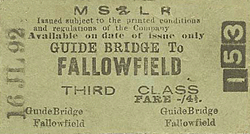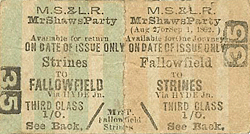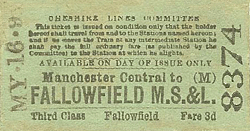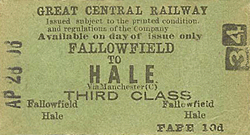| Notes: Fallowfield station was opened by the Manchester, Sheffield & Lincolnshire Railway (MSLR) on the 2nd May 1892. The station was situated on the MSLR’ Fallowfield Loop line, a 7 mile double track route that linked the Midland Railway’s Manchester South District Line from a point just to the south of Chorlton-cum –Hardy to the MSL main line |
 |
between Manchester and Sheffield at Fairfield. The reason for the line was to give the MLSR access to Manchester Central Station.
The line opened in two stages the first section opening from Chorlton to Fallowfield in September 1891. The station was located on the eastern side of a road overbridge which carried the Wilmslow Road. Fallowfield Station was provided with a handsome red brick building, in a mock Tudor style that straddled the line at street level. The building included a two storey section and had all of the usual facilities. Access to the stations two platforms which were originally provided with canopies was through the building which linked down to track level.
There was a signalbox in the middle of the westbound platform controlling access to the goods yard with a 5 ton crane which was sited on the south side of the westbound platform.
The line followed and indirect route around the southern suburbs of Manchester and had difficulty competing for local commuter traffic. Passengers in the Grorton area found it quicker to use Bell Vue or Gorton & Openshaw rather than Hyde Road and passengers from Levenshulme saved time by using the LNWR station.
 |
In 1897 the MSLR became the Great Central Railway (GCR). By this time Fallowfield was served by a local stopping service that ran between Manchester Central and Guide Bridge. In 1903 there were twenty one weekday trains in each direction and seven on a Sunday. When electric trams arrived in the early 20th century serving all intermediate stations |
except Alexandra Park they were able to provide a more direct and quicker service into central Manchester which further depleted passenger numbers on the loop line. A steady stream of express services passed through the station. a few of them stopping at Fallowfield which was the most important station on the line.
In 1923 the line became part of the LNER and Alexandra Park was renamed as Wilbraham Road
While the local passenger service on the Fallowfield loop line was in decline, goods traffic remained healthy with regular goods trains in both directions
By the 1930s the LNER had reduced the local stopping service that served Fallowfield to seven trains in each direction on a weekday with no services at all on Sundays.
The line itself continued
| to be very busy with express services which included the Liverpool Central to Harwich Parkston Quay Boat Train. Fallowfield Station and the Fallowfield Loop Line became part of the nationalised British Railways network in 1948. In 1954 consideration was given to electrifying the line. At this time the former MSL Main line (The Woodhead Route) between Manchester and |
 |
Sheffield had been electrified and it seemed sensible to continue the electrification through to Manchester Central. As things turned out only a short section of the line between Fairfield and Reddish, were a new Motive Power Depot was opened, was electrified and the wires never came close to Fallowfield.
 |
By 1958 local stopping services which still ran between Manchester Central and Guide Bridge were down to three or four on week days only. On the 7th July 1958 the service was withdrawn and Fallowfield Station closed to passenger services. Regular passenger express services continued to use the line through Fallowfield until the closure of Manchester |
Central in1969. By this date there was just one DMU a day from Liverpool to Guide Bridge and back. After that date it was only goods services passed through.The line to the east of Reddish Depot was singled in the 1970's and the last goods services used it in October 1988.
In 2001 the route of the Fallowfield Loop line was converted into a cycleway.
Further reading: The Fallowfield Line, EM Johnson 2000 Foxline Publishing .ISBN187011969X
Other web sites: Closed South Manchester Railways, The Hyde & Peak Railtour & Levenshulme then and now. Tickets from Michael Stewart
Click here to see other stations on the Fallowfield Loop Line:
Chorlton-cum-Hardy, Wilbraham Road, Levenshulme South,
Hyde Road & Fairfield. See also Debdale Park and Reddish Motive Power Depot |


old2.jpg)
old5.jpg)
2.jpg)
)20.jpg)
4.jpg)
9.jpg)
14.jpg)





old1.jpg)

 Home Page
Home Page